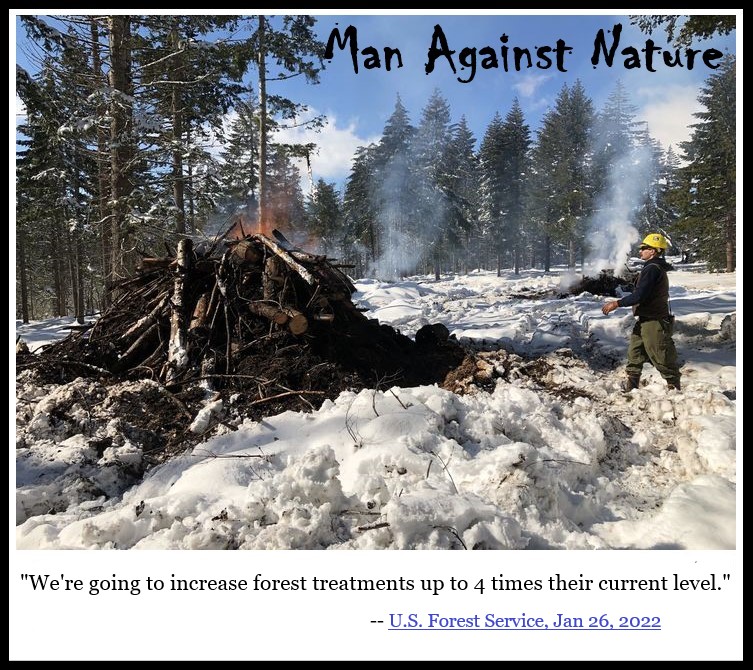|

|

|
The “man against nature” forest management paradigm is really ramping up. This paradigm says that if you don’t want high intensity forest fires, if you don’t want a lot of trees and understory burning up, then cut most trees down over vast tracts of forest before that can happen. Then burn, and periodically reburn much of what comes back. The belief is if we don’t do this, then our forests will burn catastrophically.
|
It's claimed that such treatments will create healthy and resilient forests. This discounts what we have seen from past projects, that forest ecosystems are often severely damaged by such widespread and aggressive treatments. These treatments are not compatible with the healthy and natural processes of the forest. Humans have not been successful, at least so far, in “redesigning ecosystems.”
|
The Forest Service states that they can “engineer a paradigm shift by focusing fuels and forest health treatments more strategically and at the scale of the problem, using the best available science as the guide.” And that they intend to work "collaboratively with States, Tribes, local communities, private landowners, and other stakeholders."
|
Under this 10-year strategy, they intend to work with partners to:
|
- Treat up to an additional 20 million acres on National Forest System lands.
- Treat up to an additional 30 million acres of other Federal, State, Tribal, and private lands.
- Develop a plan for long-term maintenance beyond the 10 years
This amounts to greatly increased amounts of logging, cutting and burning. So far, none of this has significantly slowed down the occurrence or intensity of wildfires, but they hope that by substantially expanding the treatments, they can achieve a better result.
|
According to independent conservation science research, wildfires are increasingly climate driven, and not primarily driven by fuels such as trees and understory. A 2016 meta-analysis of 1,500 fires by independent scientists indicated that forests which were treated with logging, thinning and prescribed burns, burned more often and more severely in wildfires than untreated forests.
|
The Forest Service needs to take into account the growing body of independent fire and forest ecology research if they want to claim they are using the best available science as their guide.
|
This has not occurred so far in the Forest Service’s planning and analysis of the two very large cutting and burning projects proposed for the Santa Fe National Forest. Between the two projects, the Forest Service proposes to log and thin up to 117,000+ acres, or 182+ square miles of our forest, and to periodically burn up to 148,000+ acres, or over 231+ square miles.
|
These projects would leave our forests unrecognizable as we know and cherish them. We would be breathing much more health-damaging prescribed burn smoke than we already are, and it would be primarily in addition to wildfire smoke, not displacing it. Yet the research of independent scientists, that could lead the Forest Service to more conservationist strategies, has not been utilized.
|
Recently, the presiding Forest Service Ranger stated about the public scoping comments for the largest of the two currently proposed projects, the “Encino Vista Landscape Restoration Project,” in the Jemez northwest of Los Alamos, "After considering all comments, I have determined that no significant issues were presented in scoping that would result in unavoidable significant effects and the need to prepare an EIS.” In fact, the scoping comments raised many extremely significant issues; they can be read online here.
|
Soon it will be time to submit draft environmental assessment comments for the Encino Vista Project. This is the largest fuel treatment project ever proposed for the Santa Fe National Forest. The amount of cutting and burning and the amount of smoke in our air from fuels treatments would be unprecedented. Stay tuned for information about how to submit comments.
|
Meanwhile, please support the paradigm that respects and works with the forest, that says “first do no harm.” We can protect homes near forests in the way that has been scientifically validated – by fire-proofing homes and removing fuels, especially fine fuels, in the 100+ foot perimeter around structures. We can do very limited, strategic and light-handed treatments if analysis shows it’s warranted, but comprehensive analysis must be done first that genuinely utilizes the best available science. An Environmental Impact Statement is clearly required for both large-scale Santa Fe National Forest projects.
|
Spread the word any way you can. Tell elected representatives and the Forest Service that you want them to be part of the solution, not a part of the problem, and to truly protect our forests.
|
And please read our latest forest ecology and protection articles on the home and news pages at theforestadvocate.org.
|
|

|
La Cueva after USFS fuel treatments. Photo: Carol Johnson
|
|
|
|
|
|